| 2003 Vol.1 |
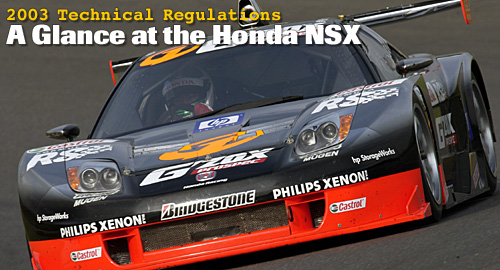
2003 Technical Regulations - A Glance at the Honda NSX
The JGTC series was founded 10 years ago, and as the 2003 season gets underway, the 10th year anniversary has brought many new changes including extensive modifications to the series' technical regulations. All 2003 model works cars of the major constructors like Toyota, Nissan and Honda are designed for compliance. And of them, the Honda NSX stands out as a remarkable example of the concepts promoted by the new technical regulations. Many ideas for the JGTC NSX came from the people at Mugen and Dome, so we have chosen the Mugen-Dome NSX as an example car for reviewing the main points of the new regulations.
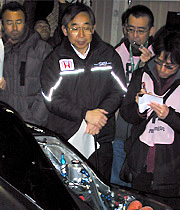
"We had already done everything we could in terms of satisfying previous regulations," explained Makoto Nagaosa, project leader at Mugen, in speaking of the targets for the new NSX design. "With the new regulation changes this year, we looked for evolutionary means as well entirely new developments. If we didn't do this, there would be no progress. The task was taken on with a rather challenging spirit."
Unrestricted Suspension Design
and Engine Orientation
Some of the biggest changes from previous years' regulations are in relation to chassis structure and layout. The new rules the car to be built utilizing a pipe-framed structure. Ahead of the front bulkhead and behind the rear bulkhead, the main frame can cut away and replaced by steel-tube framing. If the pipe-framed structure is adopted, the regulations require the chassis to be equipped with an impact absorbing structure for driver safety. As shown in the accompanying illustration, the front and rear ends of the NSX, which were originally aluminum framing, have been cut away and a steel-tube sub-frame substituted. Essentially, the introduction of pipe-frame rules has virtually opened the door to new suspension design, which had been prohibited to the point of maintaining original type and operating principles until last season.
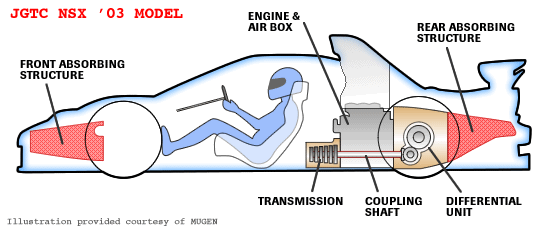
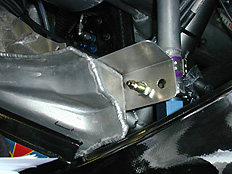 Main frame cut-away |
Regulations on engine positioning and mounting have changed drastically for 2003 as well. Rules regarding both orientation and position in the engine compartment have been revised, allowing freedom to rework weight, balance and drive-train configurations. The Honda NSX engine was originally mounted horizontally in the engine compartment behind the cockpit, but the 2003 JGTC version engine is mounted longitudinally. Moreover, the V6 block has basically been installed in reverse direction. This is a peculiarity of the 2003 NSX. "As we could not find much merit in only changing the engine mount to longitudinal, the overall layout was designed including the gearbox," said Nagaosa.
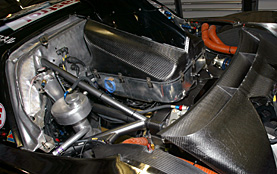
The engine is mounted longitudinally and lower to the ground
Gearbox positioning is another regulation that was revised to allow more freedom of development. This year, the NSX is equipped with a Hewland six-speed transmission that is installed in front of the engine and connected to the differential via a special coupling shaft. This layout has enabled excellent balance through focusing on weight distribution.
Flat Bottom Restriction Introduced
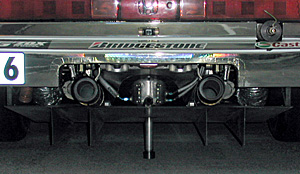 |
The regulations mentioned above are quite unique to the Japanese GT series, but there are also a number of rules that bring the JGTC cars much closer to European and American GT regulations, especially in the area of aerodynamics. Development of the modern racecar has made impressive advancements in various technological aspects. But there are a few areas where restrictions are being imposed; for example, the year 2000 regulations calling for modifications in an effort to reduce down force.
For 2003, a ruling that has been enforced for a number of years in the Le Mans and FIA regulations makes it way into the JGTC. Between the centerlines of the front and rear wheels of the car, the underbody must be fitted with a flat bottom. As a result, the down force of the car is affected remarkably. "My first impression of the car during the shakedown was... 'My goodness. What's that feeling? There's a bit less down force, I wonder?'" commented Daisuke Ito after driving the No.16 NSX entered by Mugen. "If we set the rear wing-angle to that of last year, there is entirely too little grip. There has been a tremendous reduction in down force."
One of the NSX's strongest points in the past has been aerodynamics. "The Honda NSX has been a quick car owing to its amazing down force," Ito continued, "We'll surely suffer more than our rivals with these new regulations."
But all the same, Ito is quite satisfied with the car's handling characteristics. "Outside of down force, my impression is that the car is sharp and well balanced. I think that good feeling come from the suspension work and good weight distribution."
Nagaosa also commented on the fruits of their efforts: "The outcome is not based on a single factor, it is the total effect produced by a variety of elements that counts. I think we have done well to improve the mechanical traction, and this has led to improved performance in the corners."
The best qualifying lap time of the Honda in the opening round at TI Aida (1'25.342" by Daisuke Ito) was not so far off last year's time (1'25.111" by R. Firman), which put the NSX on the pole in 2002.
Other Interesting Points in New Regulations
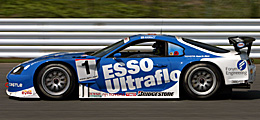 TOYOTA SUPRA 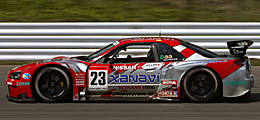 NISSAN SKYLINE GT-R 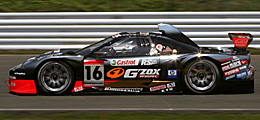 HONDA NSX |
The technical regulations for 2003 also stipulate new provisions for cars' frontal projected area and regulations regarding the use of air restrictors at high-altitude circuits. Frontal projected area is more strictly regulated giving consideration to minimum weight; the purpose of the regulation being to bring to equality the advantages and disadvantages among the various models competing. For example, the Honda NSX has to carry 20kg of weight, the Skyline GT-R is allowed to reduce weight by 20kg, and the Toyota Supra remains unchanged. Consequently, the Honda will have to carry a total additional weight of 70kg (50kg for the mid-ship engine layout).
Atmospheric pressure was also taken into considered when drafting the new regulations. The influence of atmospheric pressure is greater on the performance of naturally aspirated engines as compared to turbo-charged engines. In order to reduce the difference between these two engine types at certain circuits, cars competing with NA engines will be allowed to install larger air restrictors for races held at higher altitudes.
All provisions have been adopted for the purpose of allowing a variety of cars to race competitively against each other and reducing development costs. It goes without saying that the safety of the competitors is a priority consideration.
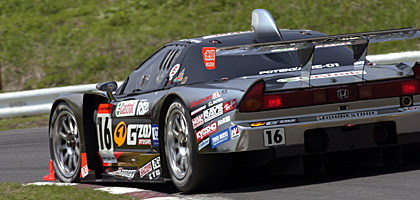
mail : info@jgtc.net